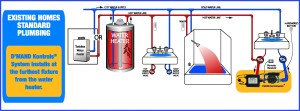A standard hot water recirculation pump, often designed to recirculate water 24/7, can cost you hundreds of dollars per year in wasted electricity, natural gas or propane.
To give you an idea of how much heat is lost, we see the temperature dropping by up to 20 degrees by the time it gets back to the water heater. The pumps are usually running all day at around 60 watts, and the water heater is kicking on about 3-4 times as often as needed. Wasted gas is not only costly, but also produces large CO2 emissions. In California, water heaters account for 38% of gas usage, giving them the largest share.
If you are one of the few using a thermostat or timer system for your hot water recirculation, you’re saving a little bit of that energy. But it’s not really enough to make a significant impact on your energy bill, or your footprint.
It turns out, there’s a way to save a much larger portion of that energy, and still get fast hot water.
“On Demand” recirculation pumps, which only turn on when needed, are a cost-effective way to get hot water to your tap immediately without wasting energy or water.
These systems, such as the D’Mand (above), respond to requests for hot water, so it only circulates when needed. They can be set up to respond to occupancy, or the push of a button. They are easily installed into existing plumbing systems, and can be installed in more than one location, for added effectiveness and flexibility. For example, we can install them under the bathroom sink, even if there’s no power there.
On demand systems are vastly more efficient than 24/7 recirculation pumps. Here’s how:
Heat loss is happening whenever there’s hot water in a pipe. The amount lost is affected by:
a) Total surface area of the relevant pipes (very difficult to improve)
b) Length of time hot water is sitting in pipes (vastly improved by on-demand systems)
c) Pipe Insulation (sometimes worth it to improve, for a decent efficiency gain)
We find that we can improve upon (b) at a much greater ratio than the other two choices. The total time your water heater is burning fuel can be reduced to a small fraction of what it was with a 24/7 pump.
[dropshadowbox align=”none” effect=”lifted-both” width=”640px” height=”” background_color=”#ffffff” border_width=”1″ border_color=”#dddddd” ]For more information about hot water systems or other home performance upgrades, call (925) 363-4498 to speak to a technician or schedule an Energy Audit. You can also e-mail: info@epbuilders.com[/dropshadowbox]
Read our Testimonials from happy homeowners!


Good post. I’m going through many of these issues as
well..